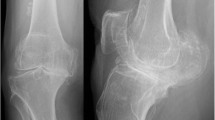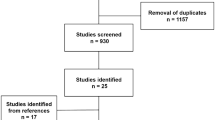Abstract
Purpose
The aim of this study was to determine factors that contribute to bone cutting errors of conventional instrumentation for tibial resection in total knee arthroplasty (TKA) as assessed by an image-free navigation system. The hypothesis is that preoperative varus alignment is a significant contributory factor to tibial bone cutting errors.
Methods
This was a prospective study of a consecutive series of 72 TKAs. The amount of the tibial first-cut errors with reference to the planned cutting plane in both coronal and sagittal planes was measured by an image-free computer navigation system. Multiple regression models were developed with the amount of tibial cutting error in the coronal and sagittal planes as dependent variables and sex, age, disease, height, body mass index, preoperative alignment, patellar height (Insall-Salvati ratio) and preoperative flexion angle as independent variables.
Results
Multiple regression analysis showed that sex (male gender) (R = 0.25 p = 0.047) and preoperative varus alignment (R = 0.42, p = 0.001) were positively associated with varus tibial cutting errors in the coronal plane. In the sagittal plane, none of the independent variables was significant.
Conclusion
When performing TKA in varus deformity, careful confirmation of the bone cutting surface should be performed to avoid varus alignment. The results of this study suggest technical considerations that can help a surgeon achieve more accurate component placement.
Level of evidence
IV.





Similar content being viewed by others
References
Bae DK, Song SJ, Heo DB et al (2013) Does the severity of preoperative varus deformity influence postoperative alignment in both conventional and computer-assisted total knee arthroplasty? Knee Surg Sports Traumatol Arthrosc 21(10):2248–2254
Bargren JH, Blaha JD, Freeman MA (1983) Alignment in total knee arthroplasty. Correlated biomechanical and clinical observations. Clin Orthop Relat Res 173:178–183
Berend ME, Ritter MA, Meding JB et al (2004) Tibial component failure mechanisms in total knee arthroplasty. Clin Orthop Relat Res 428:26–34
Berger RA, Crossett LS, Jacobs JJ et al (1998) Malrotation causing patellofemoral complications after total knee arthroplasty. Clin Orthop Relat Res 356:144–153
Bäthis H, Perlick L, Tingart M et al (2005) Intraoperative cutting errors in total knee arthroplasty. Arch Orthop Trauma Surg 125(1):16–20
Chen JY, Chin PL, Tay DK et al (2014) Less outliers in pinless navigation compared with conventional surgery in total knee arthroplasty. Knee Surg Sports Traumatol Arthrosc 22(8):1827–1832
Chua KH, Chen Y, Lingaraj K (2014) Navigated total knee arthroplasty: is it error-free? Knee Surg Sports Traumatol Arthrosc 22(3):643–649
Ensini A, Timoncini A, Cenni F et al (2014) Intra- and post-operative accuracy assessments of two different patient-specific instrumentation systems for total knee replacement. Knee Surg Sports Traumatol Arthrosc 22(3):621–629
Hasegawa M, Yoshida K, Wakabayashi H et al (2013) Cutting and implanting errors in minimally invasive total knee arthroplasty using a navigation system. Int Orthop 37(1):27–30
Heyse TJ, Decking R, Davis J et al (2009) Varus gonarthrosis predisposes to varus malalignment in TKA. HSS J 5:143–148
Inui H, Taketomi S, Yamagami R et al (2016) Twice cutting method reduces tibial cutting error in unicompartmental knee arthroplasty. Knee 23(1):173–176
Iorio R, Bolle G, Conteduca F et al (2013) Accuracy of manual instrumentation of tibial cutting guide in total knee arthroplasty. Knee Surg Sports Traumatol Arthrosc 21(10):2296–2300
Iorio R, Mazza D, Bolle G et al (2013) Computer-assisted surgery: a teacher of TKAs. Knee 20(4):232–235
Jeffery RS, Morris RW, Denham RA (1991) Coronal alignment after total knee replacement. J Bone Joint Surg Br 73(5):709–714
Khodadadyan-Klostermann C, von Seebach M, Seebach M, Taylor WR, Duda GN, Haas NP (2004) Distribution of bone mineral density with age and gender in the proximal tibia. Clin Biomech (Bristol, Avon) 19(4):370–376
Kim TK, Chang CB, Kang YG et al (2010) Execution accuracy of bone resection and implant fixation in computer assisted minimally invasive total knee arthroplasty. Knee 17(1):23–28
Lotke PA, Ecker ML (1977) Influence of positioning of prosthesis in total knee replacement. J Bone Joint Surg Am 59(1):77–79
Love GJ, Kinninmonth AW (2013) Training benefits of computer navigated total knee arthroplasty. Knee 20(4):236–241
Lustig S, Fleury C, Goy D et al (2011) The accuracy of acquisition of an imageless computer-assisted system and its implication for knee arthroplasty. Knee 18(1):15–20
Minns RJ (1992) Surgical instrument design for the accurate cutting of bone for implant fixation. Clin Mater 10(4):207–212
Ohmori T, Maeda T, Kabata T, Kajino Y, Iwai S, Tsuchiya H (2015) The Accuracy of initial bone cutting in total knee arthroplasty. Open J Orthop 5:297–304
Otani T, Whiteside LA, White SE (1993) Cutting errors in preparation of femoral components in total knee arthroplasty. J Arthroplasty 8(5):503–510
Plaskos C, Hodgson AJ, Inkpen K et al (2002) Bone cutting errors in total knee arthroplasty. J Arthroplasty 17(6):698–705
Ritter MA, Davis KE, Meding JB et al (2011) The effect of alignment and BMI on failure of total knee replacement. J Bone Joint Surg Am 93(17):1588–1596
Scholes C, Sahni V, Lustig S et al (2014) Patient-specific instrumentation for total knee arthroplasty does not match the pre-operative plan as assessed by intra-operative computer-assisted navigation. Knee Surg Sports Traumatol Arthrosc 22(3):660–665
Teeny SM, Krackow KA, Hungerford DS et al (1991) Primary total knee arthroplasty in patients with severe varus deformity. A comparative study. Clin Orthop Relat Res 273:19–31
Terauchi M, Shirakura K, Katayama M, Higuchi H, Takagishi K (1998) The influence of osteoporosis on varus osteoarthritis of the knee. J Bone Joint Surg Br 80(3):432–436
Yau WP, Chiu KY (2008) Cutting errors in total knee replacement: assessment by computer assisted surgery. Knee Surg Sports Traumatol Arthrosc 16(7):670–673
Acknowledgements
We would like to thank Dr. Yasunori Sato, Chiba University for assisting us in our statistical analysis.
Author information
Authors and Affiliations
Corresponding author
Ethics declarations
Conflict of interest
The authors declare that they have no conflict of interest.
Funding
No funding was obtained for the work associated with this study.
Ethical approval
All procedures performed in studies involving human participants were in accordance with the ethical standards of the institutional and/or national research committee and with the 1964 Helsinki declaration and its later amendments or comparable ethical standards.
Informed consent
Informed consent was obtained from all individual participants included in this study.
Rights and permissions
About this article
Cite this article
Tsukeoka, T., Tsuneizumi, Y., Yoshino, K. et al. Case-related factors affecting cutting errors of the proximal tibia in total knee arthroplasty assessed by computer navigation. Knee Surg Sports Traumatol Arthrosc 26, 1493–1499 (2018). https://doi.org/10.1007/s00167-016-4397-2
Received:
Accepted:
Published:
Issue Date:
DOI: https://doi.org/10.1007/s00167-016-4397-2




